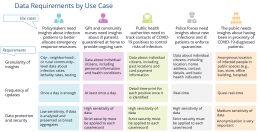Quantum Computing: Revolution or Hype?
If you’ve been following the latest technological advancements, you might have heard about quantum computing. As with every technology in its infancy, there are usually two extreme points of view. The optimists believe in almost instant revolution, with no hurdles. The pessimists will see hurdles everywhere, without really wanting to understand the potential of technology. At the end of this blog, you should be able to judge for yourself — and see that the reality is probably somewhere in between.
What Is Quantum Computing?
Quantum computing is the fifth phase of the computing era. Every era has been characterized by the system used to represent the basic piece of information — the bit. These systems have evolved from the use of vacuum tubes back in the 1950s, all the way to the current microprocessors. Four previous generations have processed the bit in a traditional way, where one bit can form only two states — 1 or 0. The quantum bit, however, also known as a qubit, uses the properties of quantum physics, where one bit can be both 1 and 0 at the same time (so-called superposition). Therefore, with only two qubits, quantum computers can represent 2² states, three qubits 23, all the way to n qubits 2n. For instance, the quantum-based Sycamore processor by Google, which famously claimed quantum supremacy, has 53 qubits. That’s over 9 quadrillion possible states. Let the magnitude of that sink in for a while. Such systems represent an exponential growth in computing power, completely changing the computing paradigm and offering the potential to solve problems that current supercomputers can’t. The possibilities are enormous.
Challenges
So, why don’t we already have quantum laptops? To achieve and keep the quantum properties, namely superposition and entanglement (for two particles communicating across huge distances —”Spooky action at a distance,” as coined by Albert Einstein), the quantum system needs very specific conditions to protect the qubits from external disturbances. Any such disruption could lead to the loss of quantum properties, also known as de-coherence, and consequently to loss of information. This requires very advanced physical systems with specific conditions, keeping the temperature just above absolute zero and completely isolating the underlying qubits from the external world. Additional to the external environment, de-coherence might also be caused by the inner workings of a quantum computer, and again lead to loss of information. All these specific properties make it difficult and resource intensive to build such systems.
Technology Approach
As with every new technology, the market is flexible and responds to the challenges in some highly adaptive ways. There are a number of players in the quantum computing market. Those that have built a full-scale quantum system (such as Google, IBM, and Microsoft) are coming up with different technical solutions, for the system itself and for the lower level qubit representation. The circuit-based model holds the most promise so far, analogous to the logic gate systems from the classical computers. One of the circuit gate models’ specific implementations is the topological quantum computer, where Microsoft is putting its bets. It uses the topological properties — the bending ability of objects while maintaining the same shape — to keep the quantum information intact and reduce the error rate. Various other models and qubit implementations are evolving, though it is not yet known which will win out.
Simulators and Cloud
Other companies (Atos, Fujitsu) are focusing on building quantum-related simulators — technologies that emulate only some specific behavior of quantum computers. Though they’re not full-scale quantum systems, they can still be used for some specific purposes, including the random number generators in finance and other computationally less complex problems.
As with other resource-extensive emerging technologies such as AI, we’re also seeing the emergence of cloud services when the end user accesses the quantum systems through the classical computer. For example, IBM offers its IBM Quantum experience — a cloud platform for programming and experimenting with real quantum hardware or the simulators. During the COVID-19 pandemic, D-Wave has offered access via cloud to anyone working on the response to the virus — be it pharmaceutical specialists or mathematicians modeling the spread of the disease.
Ecosystem and Partnerships
This leads us to the most important piece of the market response puzzle — partnerships among stakeholders. As is often the case for emerging technologies, we have seen some partnerships among vendors and universities and research centers. Vendors gain through increased R&D capacity (infrastructure and people/skills), while the universities benefit from access to the quantum systems and software. Access to these frameworks is often open source and engenders community feeling around the quantum technologies. This is underlined by the partnerships with the academic sector, with start-ups, corporations, and even end users already experimenting with quantum computers to see if they can harness their power to tackle real business problems, as highlighted in IDC’s recent Worldwide Quantum Computing Use Cases Report. Overall efforts are supported by growing institutional investments, not only from national governments but also from international institutions (including the EU’s quantum flagship program).
So, Is Quantum Computing a (r)Evolution or Hype?
Maybe the right question for the quantum computing market should be: Is it revolution or evolution? We believe it is currently at the superposition of both, and only time will tell which way the quantum (r)evolution function goes. While there are currently not many real business use cases where the use of quantum computers would be more efficient than the current ones, the possibilities are growing. We see growth in both the technical and business sides. In October 2019, Google announced Quantum Supremacy — a quantum computer’s ability to solve well-defined problems exponential times faster than the current most powerful supercomputer. Even though there has been some criticism — that the problem is very specific and not useful in real life, and IBM has argued that its supercomputer could solve the problem in a couple of days — this still has major implications. More people are becoming aware of quantum computing and businesses will be able to test its real potential. As IDC recently highlighted in our European Quantum Computing End-User Sentiment: In Search of Business Impact, 7% of European companies already do some quantum computing experimentation.
So, what are our main recommendations for keeping track of the quantum market?
- Keep in touch with technology developments:
The market is changing fast, so don’t get stuck with an outdated approach.
- Partner up:
Share the knowledge, resources, and expertise.
- Start identifying use cases across industries:
It’s important to know the end user and identify the specific use cases suitable for quantum computers.
- Start to plan the development of quantum computing skills:
Find the right balance between the technical experts (developers) and the business-oriented professionals (consultants).
For more information, please contact Stefano Perini, or drop your details into the form on the top right.
COVID-19 Contact Tracing Guide for European Governments
European governments are investing in contact tracing technology to accelerate the move to phase 2 of the COVID-19 crisis. As the economic impact of the lockdown mounts, European governments are scrambling to reopen their economies. But reopening will require a delicate balancing act — to enable as much economic activity as possible without causing a second major outbreak.
Based on the experience from East Asia, the speed at which governments are be able to track and trace new cases and their contacts and enforce targeted quarantine measures is paramount. This, along with the implementation of other WHO guidelines, such as widespread testing and reorganization of treatment capabilities, will be key for success — and this will determine not only the death toll, but the feasibility of long-term economic renewal as well.
Contact Tracing Use Cases and Capabilities
European governments need to adopt a number of new use cases linked to contact tracing — and they need to do it fast:
- Tracking of contacts by public health authorities.
- Providing information to the public on outbreaks and the need for testing.
- Tracking of quarantine adherence.
- Tracking of home-based diagnosed patients to ensure proper care.
- Strategic overview dashboards and data insights for policymakers.
All these use cases will require agility in terms of data management, and they will test governments’ commitment to data protection and governance capability in general. Governments will need to abandon their usual cautious approach to the introduction of new technologies and act with a speed that has never been seen in peace time.

Governments will face a number of challenges, from orchestration of multidisciplinary ad hoc teams to persuading the public that their data is safe. They will quickly need to adjust their enterprise architectures to enable the agile implementation of emergency COVID-related solutions.
They will also need to make sure that their employees are trained and ready to use the data tools at their disposal. While doing all this, governments will look at the examples of best (and not-so-best) practices abroad — tweaking their own processes to mirror what has worked elsewhere and avoid errors made in other countries.
Acting Fast and Informing the Public
While it’s still too early to tell which European countries are adopting the most efficient track-and-trace strategies, they face similar challenges and pathways. This is why it’s necessary in the early stages to design track-and-trace policies to ensure that they can be quickly readjusted if needed.
Data solutions will be at the core of this.
With properly designed information flows, first-line workers can focus on their job rather than on making sure they’re not putting themselves and others in harm’s way through lack of information. Policymakers can focus on bringing in innovative solutions instead of expending time just to make sure they’re not flying blind.
Last but not least, the general public, with the right information, can minimize the threat of contagion and keep morale high to ensure compliance with social distancing measures.
For more information and guidance on digital contact tracing and the value it can bring to tackling COVID-19, please see IDC’s Implementation Guide for the European Public Sector — Preparing for COVID-19 Phase 2: Adopting Contact Tracing. The guide elaborates on data and system requirements, solution architecture sourcing options, and data usage practices for each of the five key use cases.
How Business Automation Can Drive Resilience
When business conditions — and our lives — change radically, you might think that the topic of business automation is strange, or even inappropriate, to bring up.
The history of business automation is associated with two things: first, optimizing work for certainty, quality and minimum cost, rather than for speed and agility; and second, headcount reductions. Until relatively recently, the reality of business automation was that it was pretty much an all-or-nothing proposition: tasks, decisions, processes, or request handling were either automated, or they weren’t.
The New Landscape
However, the past decade of innovation in business automation technology has created a new, much more sophisticated automation toolkit that can do something very different from streamlining and reducing wasted work; it can help organizations become more flexible and resilient.
With the capabilities that now exist across what we call the new business automation toolkit — across RPA, workflow, integration platforms, AI and more — businesses of all shapes and sizes should take the opportunity to have a fresh look at automation right now.
There are three ways in which today’s business automation landscape gives organizations the ability to drive resilience in uncertain times.
- Cloud-based technologies
First, many automation vendors have enthusiastically adopted cloud-based technologies and delivery models, as well as other Third Platform technologies and innovation accelerators. The result is business automation platforms that can create new working environments that place few, if any, constraints on what work needs to be done and by whom, when it needs to be done, and where it needs to be done.
One of digital technologies’ fundamental business value drivers is that they make the coordination of all kinds of resources across time and distance more economically efficient. These are not just physical resources like materials, plant and machinery and buildings, but also people, relationships, data and knowledge. Business automation technology vendors have embraced this.
- Advanced analytics, machine learning and AI
The second feature of this new landscape comes from innovation in advanced analytics, machine learning (ML) and AI. Also, shifts in computing economics that enable us to bring contextual intelligence, predictions and recommendations right into the flow of work.
Ten years ago, it was impractical for most organizations to deliver effective “always-on” predictive models that could be deployed right into peoples’ work environments to help guide decision-making and action-taking. So people did the best they could, with the data and knowledge they could find.
The situation is different now. Modern business automation platforms can leverage advanced analytics, AI and ML techniques to create new kinds of collaboration between people. Also, they can self-improve, providing always-on “smart systems” in order to make decisions and take actions.
The result, if these new techniques are implemented well, is systems that augment the skills and experience of personnel, and which have the potential to make “everyone as good as the best”.
- Agility
The third key feature of this landscape is how it also enables more agility in the way tools themselves are used. “Low-code” and “no code” approaches are sweeping across the business automation technology landscape — from workflow, case management and more general app development, to robotic process automation (RPA), AI toolkits, and integration platforms.
All these are becoming easier to use, primarily through graphical tools that allow relatively non-technical people to design and build aspects of systems using “drag and drop” methods, without coding.
In turn, these approaches enable much wider participation in automation projects: they no longer have to be set up and delivered by hard-pressed, overworked IT departments. When they’re combined with cloud-based delivery and flexible subscription models, low-code or no-code tools enable dispersed, multidisciplinary teams to collaborate and quickly and iteratively develop business automation solutions.
What if You Don’t Adapt?
As the current situation continues to play out, many organizations are going to find themselves even more exposed by their legacy siloed systems and working practices as impacted teams try to work remotely.
Take for instance a company wedded to a traditional on-premise HR and finance system and dependent on administration via a shared service center that has been closed. Even if that organization has been building intelligence and resilience into its processes using RPA or AI-related tools to speed up the processing of forms and remove manual admin, the disconnection caused by the shutdown will massively impact on the availability of people, systems, and support.
The knock-on effect on business when things get back to normal could be immense, when core business processes like accounts payable and receivable are operating with a skeleton staff and become a barrier to getting back up to speed fast. There’s no doubt too that pressure on HR departments is going to surge, just at the time that resources are under huge pressure.
In Sum: Modern Automation Platforms Are Resilience Platforms
We’re used to looking at the value of business automation through the lenses of operating efficiency, work quality and, in some cases, customer satisfaction. However, by digging into the capabilities of modern business automation platforms and the associated services propositions, it’s clear that there’s another lens through which to look at the value: resilience.
That’s a value dimension which will continue to be top of mind in the months and years to come.
We’ll be expanding on this in a new IDC research report to be published in the coming weeks. In the meantime — please let us know what you think!
What COVID-19 Means for the Start-Up Community
The ripple effects of COVID-19 are already being felt by the global start-up community. COVID-19 is first and foremost a human tragedy, the consequences have ricocheted into our work and personal lives to a level that would have been unimaginable just six weeks ago. What began for start-ups with the cancellation of a few key events — Mobile World Congress (MWC), The Next Web (TNW), Slush — has descended into an existential crisis.
Responding to Investment Changes
Start-ups typically have a 12- to 18-month runway before seeking external investment, so those that were fundraising pre-crisis will be starting to run out of cash. As early as March 5, global VC firm Sequoia Capital released a statement describing COVID-19 as the “black swan of 2020,” painting a picture of turbulence ahead and urging founders to make “fast and decisive adjustments to changing circumstances.” If we think of a “black swan” as an extremely rare event with severe consequences that has significant ramifications for the economy, then that is pretty much spot on.
We’ve seen VCs pull term sheets and investment deals collapse. If we look at China, the first country hit by the pandemic, Chinese VC deals have contracted between 50% and 57% since the onset of the crisis between January and February. If that happens globally for two months, $28 billion will go missing in 2020 (The Impact of COVID-19 on Global Start-Up Ecosystems). Start-ups and scale-ups are a crucial engine for generating jobs, but they face the same questions as enterprise: should they cut costs or slash jobs to weather the storm?
Government Support in Europe
The government support in Europe has been heartening. Denmark is covering 75% of salaries for companies that do not cut staff and Germany is covering 60% of new salaries reduced to part-time. The U.K. has revealed £20 million in grants for start-ups to work on projects that are helping to deliver tools for critical industries hard hit by the crisis. France has allocated €4bn in funding for start-ups affected by the coronavirus pandemic including a partnership with Bpifrance who are allocating up to €80 million to de-risk private investment. These initiatives are crucial for keeping innovation afloat. But if this goes on for much longer, this will not go far enough to protect some of the start-ups that have emerged in the past five years.
It’s Not All Doom and Gloom
Though we have never seen a pandemic of this scale, the start-up ecosystem has weathered many a storm. The dot-com bubble and the Great Recession found start-ups that pivoted and reshaped their business models coming out the other side stronger. External funding may come to a grinding halt at the peak of this crisis and valuations will come down, but there will be more funding after the crisis ends.
How Start-Ups Are Supporting Europe’s Coronavirus Efforts
The strength of the health tech space in Europe has been extremely impactful. We are increasingly seeing governments turn to innovators for the answers to some of the challenges during the crisis. In the U.K., Babylon Health created a symptom tracking app for COVID-19 to enable users to complete a short questionnaire and understand where to escalate to. Iceland-based Sidekick Health has built a digital platform for everyone in Iceland who suspects they may have COVID-19. Users can assess symptoms with a doctor, then be monitored every 12 hours. Doctolib made its teleconsultation platform freely available to all doctors in France. Qoorio in Lithuania built a social support platform which connects individuals looking for solutions to various problems to build up a COVID-19 support community.
It’s not just health tech either. There are some excellent examples of #CoronaKindness throughout the start-up community. Organizations have come together to solve challenges for a growing societal need. MiiMOSA, a crowdfunding platform for food and agriculture, is collaborating with Geev, a donations platform, and Phenix, a food waste app, to deliver meals to hospitals and care givers.
When Sidekick Health CEO Tryggvi Thorgeirsson was asked about his collaboration with the Icelandic government in the wake of COVID-19, he said, “I feel like this can accelerate the adoption of digital health by one or two years … Clinicians and authorities have been dragging their feet a little bit, and now they need this. Everyone is running fast and learning how best to adopt digital tools and implement them into healthcare.”
What’s Next?
Over the coming months we will see some technologies adopted at a faster rate as a crisis of this magnitude forces us to rethink the way we function as a society. Start-ups will be at the forefront of generating the much-needed innovation during and after the crisis.







